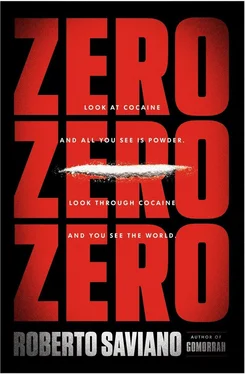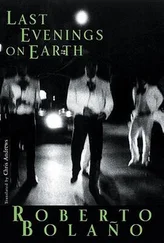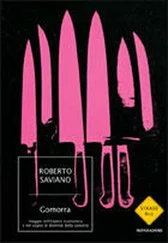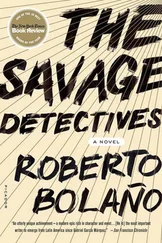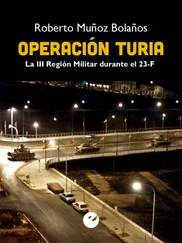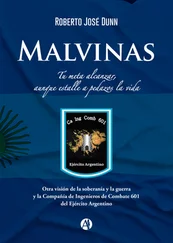These are things that people who organize maritime drug transport know well. They know that there are seamen who are well paid yet eager to earn more, as well as a growing number who work under the table and are underpaid. But that’s not the main reason that cocaine continues to travel primarily across the Atlantic. In order to move enormous quantities, up to ten or more tons in a single shipment, you need a huge ship. This makes it more affordable and lowers transportation costs by amortizing them, just as with any other export-import business, even though it increases the risks. Move the merchandise across the ocean in the safest way possible: that’s the only rule of narco-trafficking by sea. Such a simple axiom in theory, yet in practice it sparks an incessant search for new means, new routes, new methods of unloading the goods, new cover merchandise.
The world is like a single body that needs to be bathed constantly in cocaine. If one channel becomes obstructed by stricter controls, another must be found right away. So while cocaine used to be shipped mostly from Colombia, in recent years more than half the ships bound for Europe have sailed from Venezuela, and then from the Caribbean, West Africa, and Brazil. The country that used to hold the monopoly on drugs has slipped to fifth place.
Spain is still the point of entry par excellence: Nearly half of all cocaine seized in 2009 was headed there. France has just barely surpassed Holland. Yet that statistic seems odd when you look at a map. It’s based on seizures that for the most part occurred at sea, off the French Antilles or at some port of call along the African coast. In any case, once the routes toward the traditional northern European stronghold began to be controlled more rigorously, drug traffickers reacted immediately. They diverted traffic from the port of Rotterdam to that of Antwerp, which led to twice as many seizures in Belgium. In Italy, when the Gioia Tauro port came under tighter control, they fell back on Vado Ligure, Genoa, and Livorno, or rerouted shipments from Naples to Salerno. Transporting cocaine is like playing dominoes. If you move one tile, you have to rearrange all the others too.
The story of cocaine’s journey starts at the end. It’s the destination that determines both details and design. It’s one thing if the cocaine lands on the continent after being transferred from the mother ship onto smaller, more agile craft that can dock anywhere, another if the ship has to unload its secret fruit in port, after going through customs controls. In the latter it’s essential to hide it perfectly inside some other goods, whereas in the former you can choose some less sophisticated cargo as cover, or even do without. Mother ship : Drug trafficking revives the metaphorical force of maritime language. This is also true for the Spanish term, tripulantes, which means “crew” but which is derived from the verb tripular, which originally meant “to lead,” or “to guide.” Cocaine’s tripulantes are men who guide it to a safe haven. At times they’re corrupt sailors or crew members, at others they’re cartel men who board an uncompromised ship in order to guard the hidden cargo.
Sometimes the traffickers purchase the mother ship outright, as in the case of the Mirage II; other times they simply lease it, purchasing only the complicity of the tripulantes. They also use cargo ships, as Fuduli did with the Maersk Sealand vessels, and cruise ships, whose owners, together with legal export companies — often big multinationals — are totally unaware of the precious parasite they’re harboring inside the containers in the hold. In that case the shipments are called “blind loads.”
A transfer at sea offers several advantages: greater flexibility; and less complex and often less expensive planning, which therefore is quicker to organize. The sooner the coke is put on the market, the quicker the investment starts turning a profit. This still seems to be the most widely used method of getting cocaine into Europe, judging by the drugs seized on their way to Spain or off the coast of West Africa. But keep in mind that, in general, these shipments are hidden less hermetically, and thus easier to intercept.
The Mexican cartels have come up with a transshipment variation that mirrors their baroque taste for destructive waste, but that’s also an astute, effective tactic. Narco sea landings are, for a start, a speedy way to load cocaine without having to pass through heavily controlled ports. They take a car, stuff it full of coke, and take it for one last spin, to the top of a cliff, open the windows, and push it over the edge, into the sea. It could be a pickup or a jeep, one of their favorite makes, a Grand Marquis or a Cherokee. Both stay afloat just long enough for the cargo inside to be salvaged. Most of the packets, sealed in plastic, float to the surface, where they’re easily collected by men who arrive on a rubber raft or motorboat. They either deliver the coke directly to its destination or transfer it to a larger vessel. But all this has to come off without a hitch. So the narcos resort to various roadblock techniques to prevent access to the area where it’s happening. A narcobloqueo is often an act of spectacular violence that usually relates to a form of retaliation, ambush, or some other act of war. Armed commandos station themselves at various points along a road, or even a whole network of roads, where they hijack trailer trucks or force passengers off a bus. Then they position the vehicles sideways across the road, shoot out the tires, water them with gasoline, and set them on fire. This serves two purposes: They can get to the crash site without police or rival groups’ interference, and they sow terror.
It usually takes far less effort to recover the crashed cargo, though. A moving roadblock is often enough, with cars speeding in the wrong direction, causing accidents or traffic jams on streets near the transfer point — the same tactic is used to cover a boss’s escape route. In both cases the narcobloqueo creates a diversion, because the police have to try and reach the roadblock. In the meantime, the last packets of cocaine come floating to the surface undisturbed, and are scooped aboard.
• • •
The Mexican and Colombian cartels demonstrate their power through a mother ship that only they now use in any systematic way: the submarine. Every aspect of their power is summed up and symbolized by these vessels: economic and military power, as well as geopolitical control. It’s difficult to imagine the number of submarines and semisubmersible vessels — drug subs — stuffed with tons of cocaine that are moving through the water of the Pacific Ocean, between Colombia and Mexico, as well as along the more frequented Caribbean routes off the coast of Florida. Semisubmersibles move through the water with only twenty-eight inches, or ten square feet, of hull exposed, and take in air for the diesel engine through a so-called snorkel pipe. They can travel up to three thousand miles. Actual submarines can travel the entire route at a depth of one hundred feet, surfacing only at night to recharge the engine. It takes from two to a dozen crew to operate a drug sub, but the job demands more than just specialized training. These vessels are called “coffins,” after all. They’re so low and narrow inside that they have to be steered lying down, and so hot that other nicknames come to mind, such as “nonstop tanning bed.” But in truth, it’s not unlikely that they turn into actual rather than merely metaphorical coffins. No one knows how many of them have sunk into the abyss along with their cargo and a handful of men mourned only by some South American sailors’ women. On the other hand, they can carry up to ten tons of cocaine. Which is why American authorities are increasingly anxious. Submarines leave hardly a trace, other than perhaps a wake on the radar screen, which can never be attributed with certainty to an underwater vessel. What’s more, the narcos’ traditional means of transport — motorboats, fishing craft, fast ships — have only a tenth of a submarine’s cargo capacity.
Читать дальше
